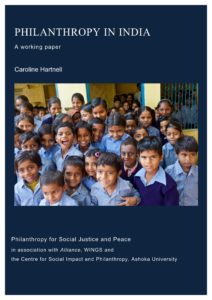By Birger Stamperdahl
 The non-profit sector in India is perhaps unlike that of any other country. By many accounts, the sector is massive, made up of hundreds of thousands of registered groups ranging from neighbourhood associations to well-organized non-profits with national reach. The diversity and size of the sector is probably larger than that of any other Asian country. Yet, as clearly outlined in Caroline Hartnell’s research paper entitled Philanthropy in India, published in October 2017 by Philanthropy for Social Justice and Peace, a major barrier to philanthropy’s growth in India is a pervasive lack of trust in its own non-profit sector, which would in a traditional western framework be the primary recipient of philanthropic funding.
The non-profit sector in India is perhaps unlike that of any other country. By many accounts, the sector is massive, made up of hundreds of thousands of registered groups ranging from neighbourhood associations to well-organized non-profits with national reach. The diversity and size of the sector is probably larger than that of any other Asian country. Yet, as clearly outlined in Caroline Hartnell’s research paper entitled Philanthropy in India, published in October 2017 by Philanthropy for Social Justice and Peace, a major barrier to philanthropy’s growth in India is a pervasive lack of trust in its own non-profit sector, which would in a traditional western framework be the primary recipient of philanthropic funding.
In the report, India philanthropy expert Pushpa Sundar is quoted as describing ‘a tremendous lack of trust between donors and ultimate recipients’ that is pervasive whether the non-profits receiving the funds are small community groups or well-established institutions. As noted by Noshir Dadrawala, director of the Centre for the Advancement of Philanthropy in Mumbai, this distrust extends beyond individual donors to corporate donors as well. Many domestic corporations have chosen to set up their own foundations and implement their own programmes rather than partner with existing non-profits.
I personally have taken part in conversations with India-based corporations, India-based managers of international foundations, and members of wealthy Indian families. In many of these conversations, donors reveal they have decided to completely bypass India’s non-profit sector in favour of government partnerships, for-profit impact investing, and/or establishing their own implementing organizations. Certainly, cultural perspectives contribute to a lack of engagement with third-party non-profits. In one conversation, a member of a wealthy family owning a large domestic corporation said this of their charitable work: ‘It is my family’s duty to do this. We will not hand it over for someone else to do.’
When I consider these conversations, three factors – not at all unique to India – may partially contribute to donor decision-making.
- Lack of trust: a belief that third-party non-profit actors are not accountable or trustworthy
- Perception of risk: a belief that alternatives to third-party non-profit actors present less risk while delivering acceptable programme impact
- Power dynamics: a difficulty in shifting traditional ownership of programme decisions from donors to implementers
When looking at Caroline Hartnell’s report specifically through the lens of these three factors, the report offers some opportunities and challenges for those engaged in supporting the growth of India’s philanthropic infrastructure.
Building trust
The report names ‘retail’ giving as one of the biggest success stories in Indian philanthropy today. The rise of online giving in particular does signify a change in how philanthropy is mobilized and away from personal, trusted relationships. Perhaps true transformation for philanthropy in India will come from the growing middle class and not from high net worth individuals and corporations. This is good news to the extent that infrastructure exists to protect the trust between these online donors and recipient non-profits. Given the size and complexity of India’s non-profit sector, technology platforms do seem particularly well suited to help donors navigate the sector and to make information about organizations highly transparent.
Across the board, not just with retail giving, the report describes efforts to build trust and to offer services that help donors navigate the large number of non-profits in the country. The ongoing professionalization of philanthropy seems like a very good sign, and the success of groups like Dasra suggests that trust can be built, even if it may take some time. Yet the sector and service needs in India are large, and there is need for many other organizations to fill in different infrastructure gaps. As noted by Pusha Sundar, ‘There are some organizations – GuideStar India, Credibility Alliance, GiveIndia, etc – but India needs many more.’
Reducing risk
Those with the greatest wealth appear to be less convinced by the non-profit sector and/or traditional philanthropy. Inside and outside of India, those who have created wealth for themselves in the for-profit sector may question the sustainability of a non-profit system based on ongoing philanthropy. These donors (or potential donors) would rather stick with a familiar for-profit model – even if many impact investing schemes are a hybrid of for-profit and non-profit activity. They may perceive less risk in finding new, often unproven impact investing models that if successful can be sustained with earned income. They may also prefer to support the development of government programmes. From my perspective, all of these approaches are great if they result in long-term impact. However, to some degree, a healthy non-profit sector needs to be part of the equation to fill in the gaps where we know for-profit models don’t work and where government cannot always reach. It is not an either-or equation.
Also, in the area of risk mitigation, corporate foundations in India clearly see less risk to their corporate parent’s brand if they implement programmes themselves rather than funding a third-party non-profit partner. From my perspective, coming from the United States, that decision is surprising. For example, a US pharmaceutical company considering whether to operate its own non-profit hospital would clearly see far less risk if it instead supported the work of a third-party entity. Perhaps I have that view because I come from a far more litigious society. However, in looking at the overall landscape of corporate giving under India’s new CSR legislation, it is clear that subsidiaries of international corporations are more willing to partner with India’s non-profit sector, perhaps partly due to a difference in perceived risk.
Changing power dynamics
Even funding in ‘safe’ areas, power dynamics are always involved when money exchanges hands – even in philanthropy. Ultimately the question becomes: who decides how the funds are used? Lack of trust and perceived risk play into answering that question, but so do some other issues raised in the report.
The report mentions in one place the role international NGOs have had in weakening the domestic non-profit sector. In another place, it points to a shortage of talent in the domestic non-profit sector. These two are closely related. International NGOs often tend to grab the top talent and pay higher salaries than are offered by domestic non-profits. This same trend is hampering the development of the non-profit sectors in such countries as Bangladesh and Myanmar.
This shows signs of changing in India thanks to a shift towards community-led development being embraced by both donors and international NGOs. In a community-led development model, beneficiary communities – local non-profits, local governments, and local business people – become both the primary decision makers and the implementers of programmes funded by philanthropy. Meanwhile, donors and international NGOs need to be better prepared to let go of control at the very start of the process and move into a supporting role. This model has positive by-products that include strengthened domestic NGOs and greater community ownership of programmes. This could continue to grow hand in hand with community philanthropy and community foundations in India.
I was heartened to read much of Caroline Hartnell’s report, because many of the trends pointed to in its pages suggest India’s philanthropic sector is moving in the right direction.
Birger Stamperdahl is president and CEO of Give2Asia